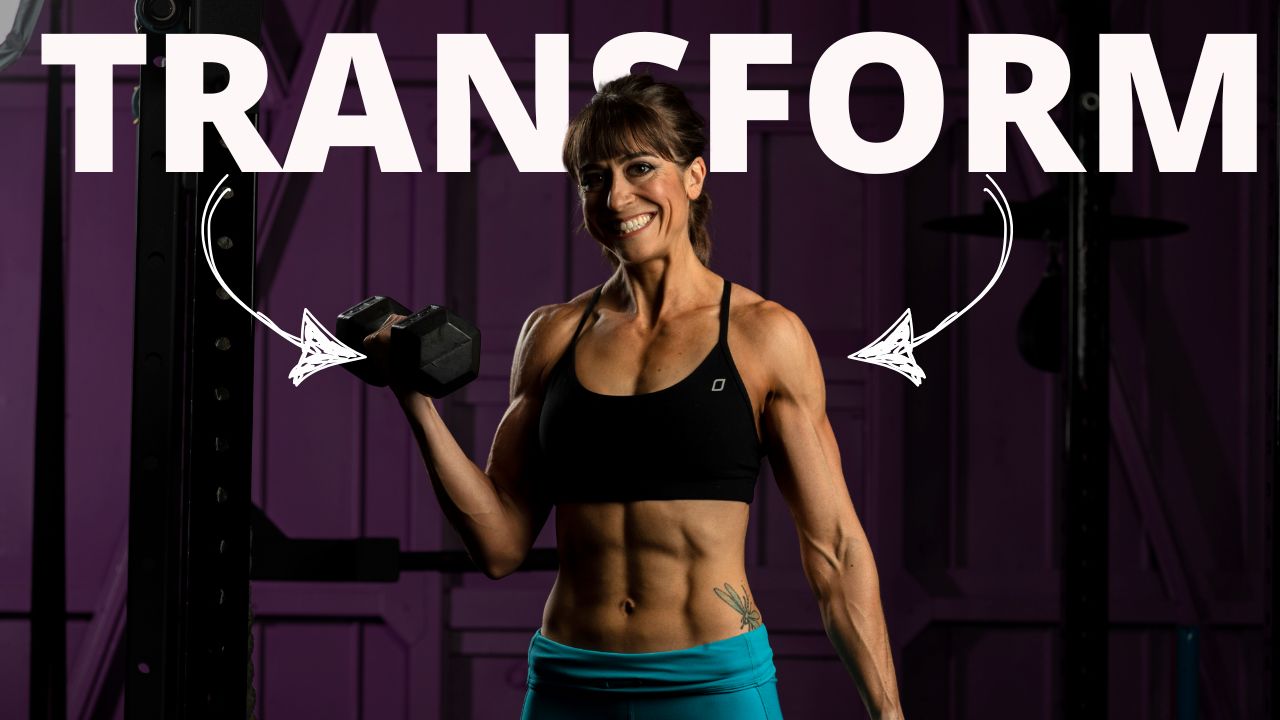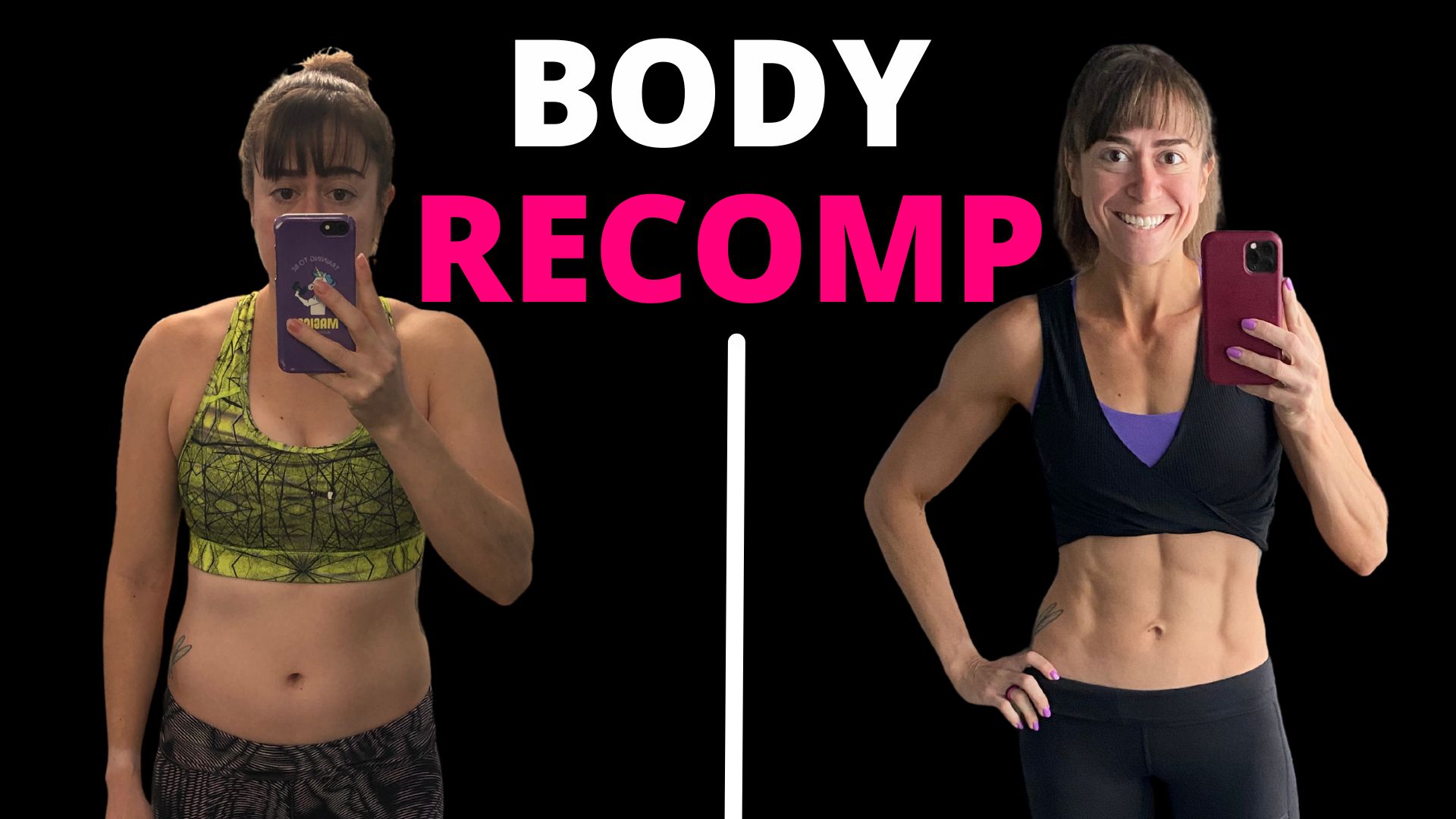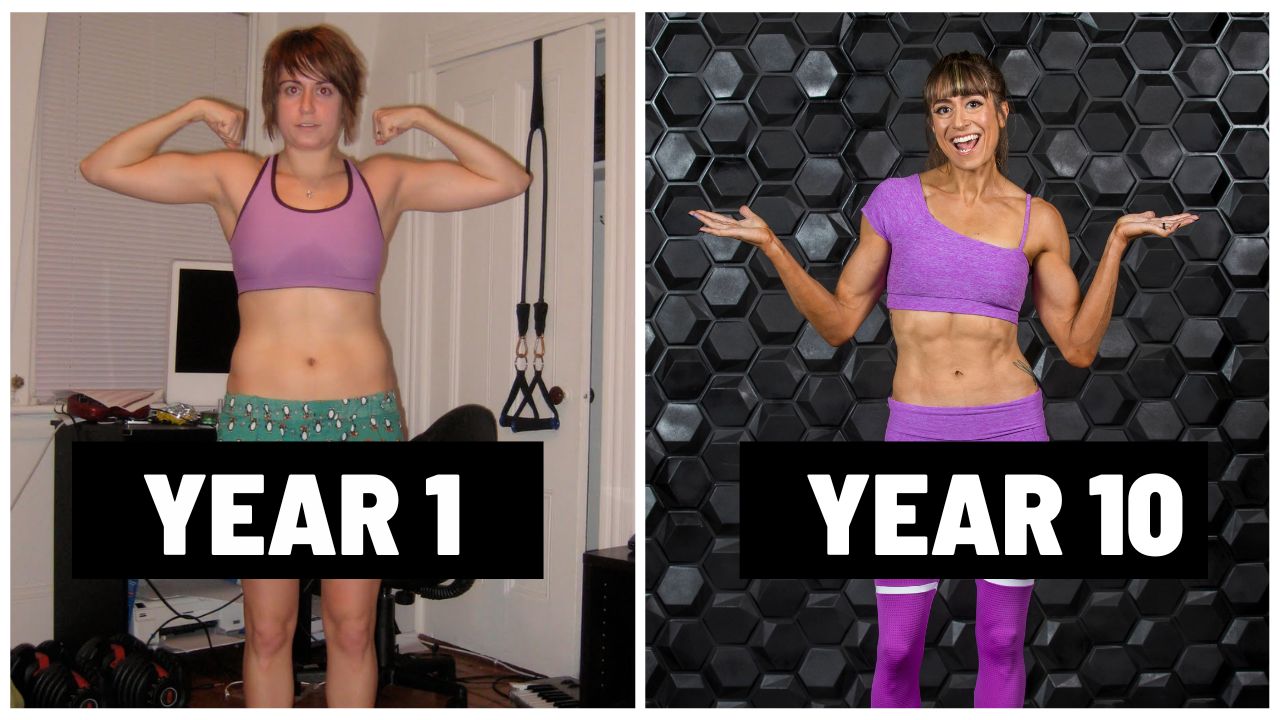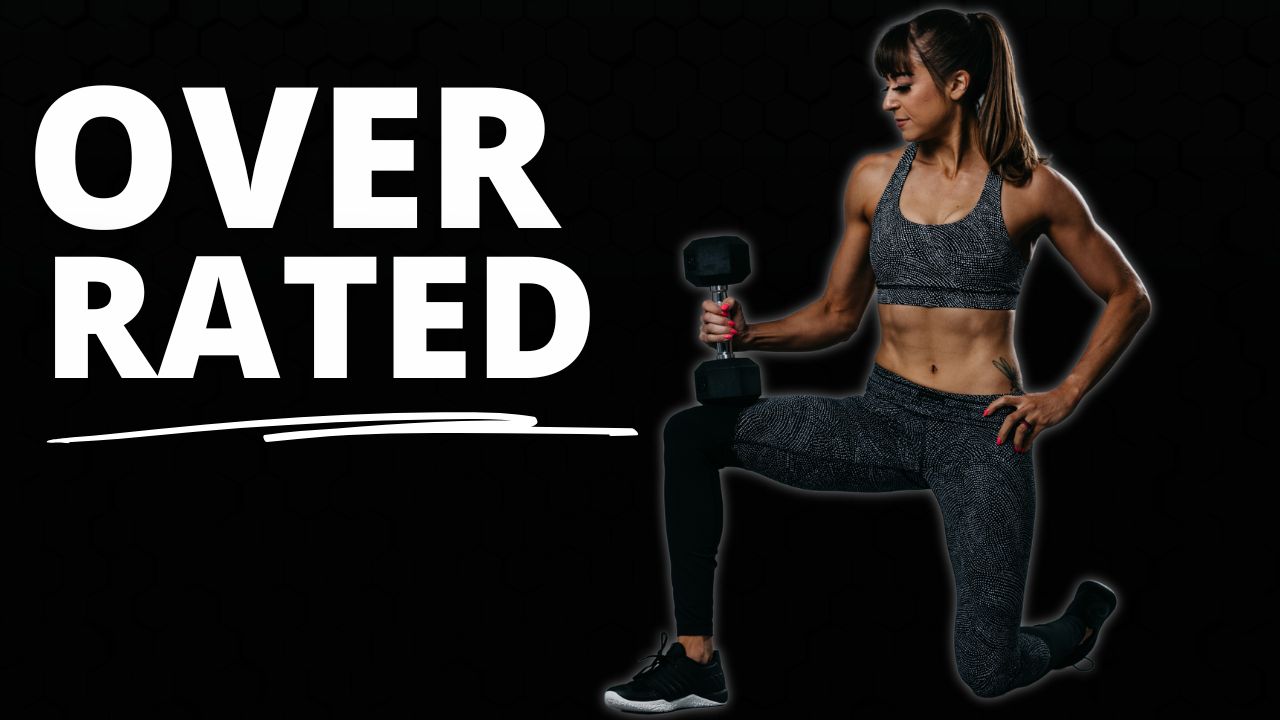
Transform Your ARMS (10 Tips For Toned Arms That Work)
I’m flattered that I tend to get a ton of compliments on my arms and shoulders. And because people seem to like them, I want to share the10 tips I think have helped me see fabulous arm definition.
And I’ll tell you tip number one is not to include more arm isolation exercises in your routine…Although I will get to 9 of those “fun” workout tweaks after this cold hard most important fact…
Focus on your macros.

Yup. Not what you wanted to hear.
Not fun or sexy. But straight facts.
My arms were never lean and defined no matter how I trained until I adjusted my diet.
Because while our training is key to building muscle, our diet is key for losing fat too.
And muscle showing through isn’t just about having more muscle. It’s about lowering our body fat percentage.
It wasn’t that I started eating super clean either when I adjusted my diet.
Honestly I focused less on forcing clean eating standards on myself and more on balance while hitting my protein.
This allowed me to get consistent, train hard and finally lose the fat covering my hard earned muscles.
So if you’ve been training hard and feel like you have a bit of fluff that’s hiding your hard work, start tracking and focus on hitting a protein minimum.
For fat loss and better results faster, shoot for 40% of your calories coming from protein.
And then don’t fear carbs!
Carbs create that anabolic environment for muscle growth and help you truly push your workouts to create the challenge needed to force muscles to adapt and grow stronger.
Low carb may lead to fast drops on the scale, but long-term it will not help you look more defined and may even lead to you losing muscle as you keep trying to train harder and harder!
Carbs are protein sparring and protect that lean muscle as you lose fat.
The next thing I found took my arm definition to the next level was combining multiple rep ranges in a workout session.
Low rep and heavy weights or high rep and lighter weights?
The answer is both.
Although I will say no weights should ever feel light. Even when you go higher rep, you want to feel “maxed out” with hitting that rep range.
Heck you want even 5lbs to feel like 100 because you truly did a rep amount that challenged you if that’s the weight you’re using.
But by combining rep ranges for different movements for your arms, you can move more quality loads over the course of your workout and recruit more muscle fibers to drive muscle and strength gains faster.
You may even use different rep ranges based on the type of move you’re performing for your arms and upper body in general.
This is why, even though you want to transform your arms, you don’t just want to do arm isolation moves.
That’s why tip number 3 is to combine compound and isolation moves using that diversity of rep ranges.
Compound Burner Sets and 6-12-25 technique are two of my favorite workout designs to see better muscle hypertrophy and definition especially for those stubborn areas.
These two workout designs combine tips 2 and 3, using not only 2-3 rep ranges in a workout but also both compound and isolation moves combined in a series.
With compound burner sets, you’ll do a compound move like a back row for 6-12 reps with heavy loads, then work your biceps to full fatigue after with higher reps of 15-20 with a bicep curl.
With 6-12-25, you may do a bench press for 6 reps, an overhead press for 12 reps then tricep push downs for 25 reps going from more compound to more isolated as the reps go up.
These designs allow you to use heavier loads, a diversity of movements and rep ranges and even work a muscle closer to failure to see better muscle gains.
And with both tip 2 and 3, don’t be afraid to also change up the type of resistance you use and even the ranges of motions and tempos!
Weights are an easy way to create progression and great for muscle growth. BUT especially the more advanced and experienced an exerciser we are, the more we can’t just rely on weights for progression.
It’s why using different rep ranges and different types of movements, including both compound and isolation is so key.
But it’s also why we need to use different types of resistance and ranges of motion to create that challenge and progression.
Bands can be a great way to help improve our muscle gains by creating often more metabolic stress.
They also apply often more resistance in the move when the muscle is strongest and can help you be forced to control that eccentric portion of the lifting, slowing it down.
They can even be combined with dumbbells for a new challenge and progression.
Loading muscles under greater stretch can also help you see better results faster. It’s why at times increasing the range of motion of a move can be key.
Performing your tricep move overhead with a bit of extra stretch at the end can not only help you hit all 3 heads, but it can help you see better gains!
This brings me to tip number 6…Use different postures and positions to hit every aspect of a muscle group.
Varying the types of bicep curls and shoulder presses and tricep exercises, can help you not only progress moves through the same but different, but help you truly see that even development.
Different aspects of muscles are worked by different movements to different extents.
Like if you do want to hit the front of your shoulder, a front raise may be beneficial. While to hit your middle delt, a lateral raise may be better.
And instead of doing 8-12 reps of each at times, you may even combine a front to lateral raise for higher reps in one workout.
Diversity done with strategy can be key!
But mix up even unilateral versus bilateral moves, single arm vs two arm, to help you also address imbalances and make sure you’re developing things evenly.
Then don’t just get caught up in trying to do MORE each and every session. More isn’t better and doing too much becomes wasted effort and volume.
We fatigue over the course of our workouts and the work becomes less quality.
Instead of doing a ton of arm movements in a single session, spread out your volume of exercises over the week.
Instead of one arm day, and 3 bicep curls in that session, hit your arms 2-3 times a week, spreading those moves out.
While it isn’t bad to create a bit more training density on a given day, that frequency for those stubborn areas can really add up!
Increasing training frequency while reducing volume per workout can help you make sure you’re working more often at that true 100% intensity to see results!
To also help you create that quality of work, move more weight over your workouts, create that training density and work a muscle closer to fatigue, all key things for better muscle gains, consider including some rest-pause technique especially in those higher rep ranges with isolation moves.
Rest-pause technique is a great way to make sure you don’t just stop when a move feels hard enough. It forces you to do those few extra reps past failure you didn’t really want to do.
But it also allows you to keep your reps quality reps.
If you’re working in that 15-20 rep range, pick a weight you max out at 15 reps with. Pause for 15-20 seconds when you get to even 13-14 reps then finish all 20. This push is going to take your gains to the next level.
This technique though is also going to cause you to feel very sore often the first few times you use it which is why fewer moves per workout and spreading those moves out to train more frequently can be key!
But use this technique to truly make yourself push past where you’re comfortable.
Too often we think we’ve pushed hard enough and stop when discomfort just starts to happen.
To break down our muscles so they have to rebuild back stronger and grow, especially the more advanced we are though requires us to push that bit extra.
That’s where this technique can come in super handy!
Now, while I’ve focused a ton on the muscle building side of transforming your arms, which is key, definition is about body fat levels as well.
This does come back to your diet. If your nutrition is on point, fluff may hide your hard work in the gym.
However, with dialing in your macros to match the recomp you want to see, focusing on protein and not fearing carbs, you may also want to consider including a bit of cardio post arm workouts if you tend to feel like you’re storing fat there.
This doesn’t mean go run for hours or do intensive HIIT that leaves you slaughtered.
But on workouts where you’ve worked your arms, you’ve mobilized more fatty acids from the surrounding tissues. You then want to make sure these mobilized fatty acids are used.
Doing some compound moves combined like in 6-12-25 and compound burner sets is one way to help yourself do this.
But so is walking or even a more upper body focused form of cardio like battle ropes.
It can be a quick light session of 10-15 minutes even once a week after your arm workouts, but this little bit of cardio right after, especially when you have only those last few percents to shave off, can be that little boost.
And while your workouts are mainly focused on building muscle for metabolic health and to have the muscle you can reveal through your nutrition, that little bit of strategic cardio can help with the fat loss side of recomp!
Because definition is about having muscle but also about losing fat!
And last but not least, be strategic in your training and make sure your arm training isn’t an afterthought!
So often we want to transform an area and do 100 moves for it on like one day with no real strategy or purpose or progression.
This ends up in us working hard without results to show for it.
Design a clear weekly schedule, track your numbers and repeat your workouts for 3 weeks minimum.
Use these tips to include diversity over that week that you repeat to see yourself add reps or weights or even advanced movements over that time.
That progression and build off of the week before is what transforms those arms!
And then over time, adjust the moves or techniques you use to keep honing in on stubborn areas to create that balance!
But failing to plan is planning to fail! We need to track and monitor progress to adjust and adapt over time!
Dial in your diet and your workouts to build your leanest, strongest body ever with my 1:1 Coaching…







